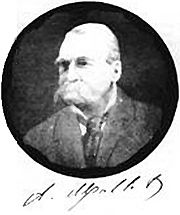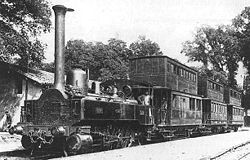
Anatole Mallet
Encyclopedia


Compound locomotive
A compound engine unit is a type of steam engine where steam is expanded in two or more stages.A typical arrangement for a compound engine is that the steam is first expanded in a high-pressure cylinder, then having given up heat and losing pressure, it exhausts directly into one or more larger...
for a railway steam locomotive
Steam locomotive
A steam locomotive is a railway locomotive that produces its power through a steam engine. These locomotives are fueled by burning some combustible material, usually coal, wood or oil, to produce steam in a boiler, which drives the steam engine...
, patented in 1874.
In 1876 he introduced a series of small 2-cylinder compound 0-4-2
0-4-2
Under the Whyte notation for the classification of steam locomotives, 0-4-2 represents the wheel arrangement with no leading wheels, four powered and coupled driving wheels on two axles, and two trailing wheels on one axle...
tanks
Tank locomotive
A tank locomotive or tank engine is a steam locomotive that carries its water in one or more on-board water tanks, instead of pulling it behind it in a tender. It will most likely also have some kind of bunker to hold the fuel. There are several different types of tank locomotive dependent upon...
for the Bayonne
Bayonne
Bayonne is a city and commune in south-western France at the confluence of the Nive and Adour rivers, in the Pyrénées-Atlantiques department, of which it is a sub-prefecture...
-Anglet
Anglet
Anglet is a commune in the Pyrénées-Atlantiques department in Aquitaine in south-western France. The town's name is pronounced [ãglet]; i.e...
-Biarritz
Biarritz
Biarritz is a city which lies on the Bay of Biscay, on the Atlantic coast, in south-western France. It is a luxurious seaside town and is popular with tourists and surfers....
Railway in France
France
The French Republic , The French Republic , The French Republic , (commonly known as France , is a unitary semi-presidential republic in Western Europe with several overseas territories and islands located on other continents and in the Indian, Pacific, and Atlantic oceans. Metropolitan France...
. He subsequently designed an articulated
Articulated locomotive
Articulated locomotive usually means a steam locomotive with one or more engine units which can move independent of the main frame. This is done to allow a longer locomotive to negotiate tighter curves...
compound system with a rigid chassis at the rear carrying two high-pressure cylinders plus two low-pressure ones mounted on an articulated front driving truck
Bogie
A bogie is a wheeled wagon or trolley. In mechanics terms, a bogie is a chassis or framework carrying wheels, attached to a vehicle. It can be fixed in place, as on a cargo truck, mounted on a swivel, as on a railway carriage/car or locomotive, or sprung as in the suspension of a caterpillar...
, patented in 1884 with full rights granted in 1885. This was first used for a series of narrow gauge locomotives specially built by the Decauville
Decauville
The Decauville manufacturing company was founded by Paul Decauville , a French pioneer in industrial railways. Decauville's major innovation was the use of ready-made sections of light, narrow gauge track fastened to steel sleepers; this track was portable and could be disassembled and transported...
Company in 1888 for the Paris Exposition of 1889
Exposition Universelle (1889)
The Exposition Universelle of 1889 was a World's Fair held in Paris, France from 6 May to 31 October 1889.It was held during the year of the 100th anniversary of the storming of the Bastille, an event traditionally considered as the symbol for the beginning of the French Revolution...
. This arrangement became known as the Mallet locomotive
Mallet locomotive
The Mallet Locomotive is a type of articulated locomotive, invented by a Swiss engineer named Anatole Mallet ....
.
He was awarded the Elliott Cresson Medal
Elliott Cresson Medal
The Elliott Cresson Medal, also known as the Elliott Cresson Gold Medal, was the highest award given by the Franklin Institute. The award was established by Elliott Cresson, life member of the Franklin Institute, with $1,000 granted in 1848...
of The Franklin Institute in 1908.
External links
- There is a relevant English-language forum at Railways of Germany

